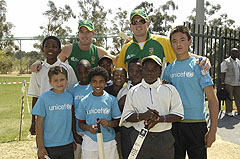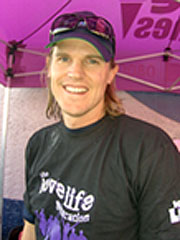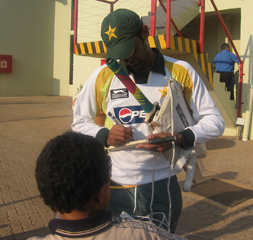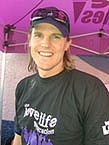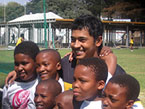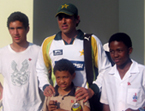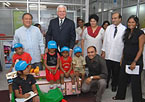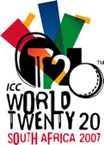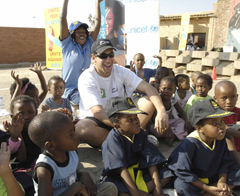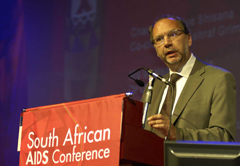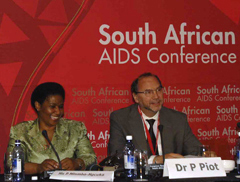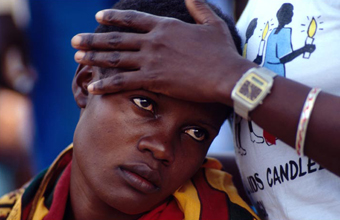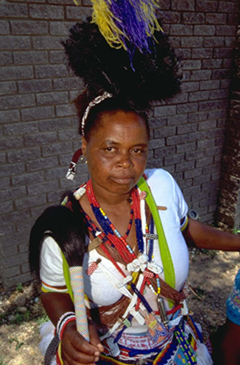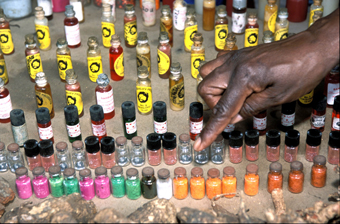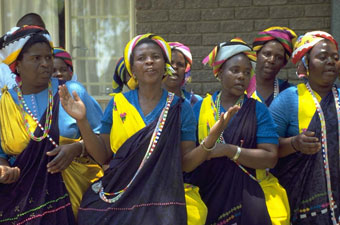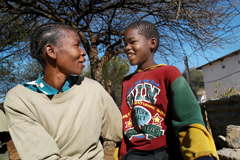 Le Plan stratégique de lutte contre le VIH, le sida
Le Plan stratégique de lutte contre le VIH, le sida
et les IST pour l’Afrique du Sud 2007-2011 détaille
les cibles concrètes à atteindre dans des domaines
précis d’ici 2011. Crédit photo : ONUSIDA/E. MillerEn Afrique du Sud, la riposte au sida a reçu un coup de pouce grâce à l’approbation de deux processus clés : la restructuration du Conseil national d’Afrique du Sud sur le sida (SANAC) et le lancement d’un nouveau plan national de lutte contre le sida qui orientera la riposte du pays au cours des cinq prochaines années.
Le Conseil restructuré est un organe partenarial multisectoriel de haut niveau présidé par Mme Phumzile Mlambo-Ngcuka, Vice-Présidente d’Afrique du Sud, et dont le vice-président à élire sera un représentant de la société civile. Le Conseil comprend des ministres et des responsables de 18 secteurs de la société civile ; il jouera un rôle de chef de file pour rallier tous les suffrages sur les questions de stratégie et de politiques concernant le sida. Le Conseil supervisera aussi la mise en œuvre et l’examen d’ensemble du nouveau Plan stratégique national.
Présenté comme le document actuellement le plus complet et le plus dynamique d’Afrique du Sud sur les questions concernant le sida, le Plan stratégique de lutte contre le VIH, le sida et les IST pour l’Afrique du Sud 2007 – 2011 s’appuie sur les enseignements de la riposte au sida du pays tirés des expériences des dernières décennies et détaille des cibles concrètes à atteindre d’ici 2011 dans des domaines précis.
Le 2 mai, le Cabinet sud-africain a officiellement approuvé le plan quinquennal. Le large processus consultatif et participatif – qui a débuté en 2006 et auquel ont participé des responsables gouvernementaux, un large éventail d’organisations de la société civile, les Nations Unies, des établissements universitaires et de recherche, le monde du travail et le mondes des affaires – a été une étape essentielle de l’élaboration du plan.
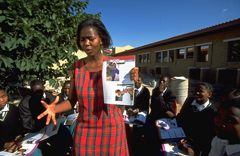 Les principaux objectifs du plan sont de réduire de
Les principaux objectifs du plan sont de réduire de
moitié le nombre de nouvelles infections à VIH et
d’atténuer l’impact du virus en élargissant l’accès à
un traitement, des soins et un appui appropriés à
80 % de l’ensemble des personnes diagnostiquées
séropositives au VIH. Crédit photo : ONUSIDA/G.
PirozziLes principaux objectifs du plan sont de réduire de moitié le nombre de nouvelles infections à VIH et d’atténuer l’impact du virus en élargissant l’accès à un traitement, des soins et un appui appropriés à 80 % de l’ensemble des personnes diagnostiquées séropositives au VIH. Les parties prenantes s’engagent aussi à réduire les taux de transmission mère-enfant du virus à moins de 5 % et à allouer 40 % du budget prévu au traitement du VIH.
Mark Heywood, du AIDS Law Project et de la Treatment Action Campaign, et membre du Groupe de référence de l’ONUSIDA sur le VIH et les droits de l’homme, qui a participé à la rédaction du document, a déclaré qu’il s’agissait d’un plan « sérieux et audacieux ». « Il reconnaît le caractère fondamental des droits de la personne et fournit des cibles qui faisaient gravement défaut concernant le traitement et la prévention du VIH en attribuant clairement les responsabilités pour que le plan se concrétise », a-t-il ajouté.
« Ce processus a permis de rapprocher le Gouvernement sud-africain de la société civile et nous a donné, en tant que nation, l’occasion de nous retrouver les uns les autres et de nous engager à nouveau pour lutter contre la propagation du VIH », a déclaré Mme Hendrietta Bogopane-Zulu, membre du Parlement, représentante du secteur des handicapés au sein du Conseil national de lutte contre le sida et membre du Groupe de travail des experts nationaux sur le sida nommé par le Directeur général du ministère de la Santé pour conduire la finalisation du plan national. « C’est un effort collectif et je pense qu’il en sera de même lorsque nous mettrons en œuvre le plan. Nous savons que grâce au plan les choses vont mieux aujourd’hui qu’hier mais que demain elles iront encore mieux », a-t-elle déclaré.
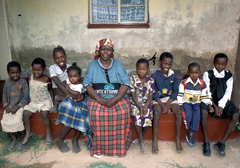 A la fin 2006, un Sud-Africain sur neuf (soit 5,5
A la fin 2006, un Sud-Africain sur neuf (soit 5,5
millions de personnes) vivait avec le VIH et la
prévalence parmi la population adulte était de
18,8 %. Crédit photo : ONUSIDA/P. VirotPendant l’élaboration des deux processus, l’ONUSIDA a travaillé en étroite collaboration avec le Conseil national de lutte contre le sida et le ministère de la Santé d’Afrique du Sud. Par l’intermédiaire de l’Equipe commune des Nations Unies sur le sida, l’ONUSIDA a aussi fourni un appui technique à plusieurs consultations de la société civile.
« Fournir un appui à ces processus a constitué une priorité de l’aide apportée par l’ONUSIDA à l’Afrique du Sud pour faire progresser sa riposte. Nous saluons la direction nouvelle et audacieuse qui a renforcé le Conseil national de lutte contre le sida et élaboré un plan national solide. Grâce aux nombreux échanges avec la société civile et d’autres partenaires l’on s’oriente vers une riposte nationale unifiée à l’épidémie », a déclaré Mbulawa Mugabe, Coordonnateur de l’ONUSIDA dans le pays, qui était aussi l’un des 16 membres du Groupe de travail.
« L’essentiel, maintenant, est de mettre en œuvre efficacement et sans tarder le plan qui sera soutenu, dans la mesure du possible, par l’ONUSIDA et la famille des Nations Unies afin que les buts fixés soient atteints », a-t-il ajouté.
A la fin 2006, un Sud-Africain sur neuf, soit 5,5 millions de personnes, vivaient avec le VIH et la prévalence parmi la population adulte était de 18,8 %. La prévalence n’a pas encore commencé à diminuer mais elle s’est stabilisée parmi les jeunes de 15 à 24 ans. La prévalence nationale du VIH parmi les femmes enceintes fréquentant les dispensaires prénatals était de 30,2 % en 2005.
En juin, l’Afrique du Sud organisera la troisième Conférence nationale sur le sida qui sera axée sur le thème : Parvenir à un consensus sur la prévention, le traitement et les soins du VIH. Cette conférence aura pour but de servir de tribune pour des délibérations sur les principales questions controversées concernant la prévention, le traitement et les soins du VIH. La Conférence nationale sera ouverte par le Dr Peter Piot, Directeur exécutif de l’ONUSIDA.
Liens:
Télécharger le Plan stratégique de lutte contre le VIH, le sida et les IST pour l’Afrique du Sud 2007 - 2011 (en anglais) (pdf, 1.6 Mb)
Site Internet du ministère de la Santé d’Afrique du Sud (en anglais)
Le Gouvernement d’Afrique du Sud en ligne (en anglais)
Davantage d’informations sur la 3ème Conférence sur le sida d’Afrique du Sud (en anglais)



